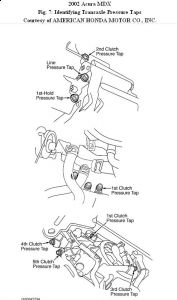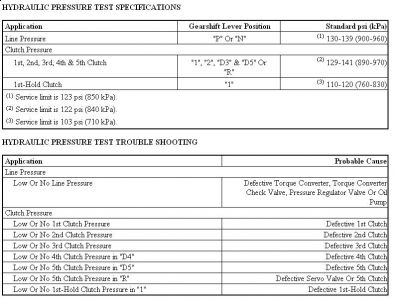DTC = Diagnostic Trouble Code.
HYDRAULIC PRESSURE TESTS
Pressure Test Preparation
Ensure transaxle fluid level is correct. Warm engine to normal operating temperature (cooling fan will engage). Apply parking brake. Raise and support vehicle so wheels can rotate.
Line Pressure Test
1. With engine off, remove pressure tap plug from line pressure tap on transaxle. See Fig. 7. Attach pressure gauge to line pressure tap. Tighten hose fitting to 13 ft. lbs. (18 N.m).
2. With gearshift lever in "P" position, start and operate engine at 2000 RPM. Note line pressure. Place gearshift lever in "N" position, and note line pressure with engine at 2000 RPM.
3. Line pressure should be within specification. See
HYDRAULIC PRESSURE TEST SPECIFICATIONS table. If line pressure is not within specification, see HYDRAULIC PRESSURE TEST TROUBLE SHOOTING table. Shut engine off.
4. Remove pressure gauge set. Using NEW seal washer, install and tighten pressure tap plug to 13 ft. lbs. (18 N.m).
Clutch Pressure Test
NOTE:
Check clutch pressure at each clutch pressure tap on transaxle. See Fig. 7.
1. With engine off, remove pressure tap plug from appropriate clutch pressure tap on transaxle. Attach pressure gauge to appropriate pressure tap. Tighten hose fitting to 13 ft. lbs. (18 N.m).
2. Start and operate engine at 2000 RPM. Note clutch pressure reading with gearshift lever in appropriate position. See HYDRAULIC PRESSURE TEST SPECIFICATIONS table.
3. Ensure clutch pressure is within specification. If clutch pressure is not within specification, see
HYDRAULIC PRESSURE TEST TROUBLE SHOOTING table. Shut engine off.
4. Remove pressure gauge set. Using NEW seal washer, install and tighten pressure tap plug to
13 ft. lbs. (18 N.m).


Saturday, April 10th, 2010 AT 9:07 AM




